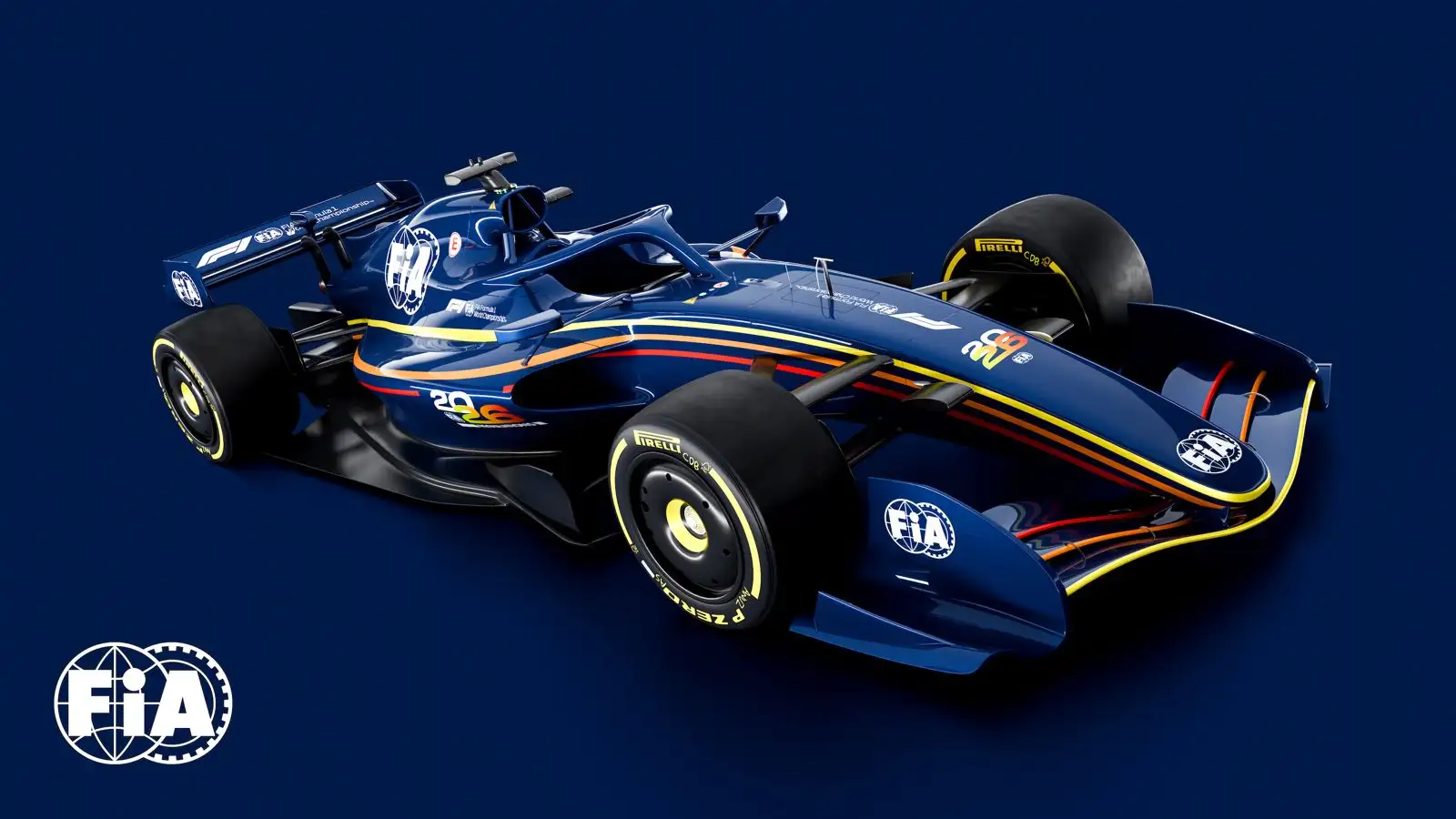The Formula 1 world is on the cusp of its next great technical reset, and if early indications are anything to go by, the 2026 season will not just be a year of change—it will be a season of shocking, audacious design. Reports from the inner sanctum of the sport indicate that the new regulation cars, initially feared to be significantly slower, are already displaying massive lap time gains in the simulator and wind tunnel, with teams having shaved a breathtaking three to four seconds off their initial baseline models.
This rapid acceleration of development confirms one thing: the high-stakes arms race for supremacy has already begun, and it is yielding extreme solutions that are pushing the limits of the rulebook.
The initial fear following the release of the 2026 regulations was centered on the power unit’s drastic shift to a 50/50 split between the Internal Combustion Engine (ICE) and battery power. This, combined with smaller, lighter chassis and simplified aerodynamics, was expected to drastically reduce cornering speeds. Yet, in just a few short months, the savants in the F1 paddock—the engineers and designers—have collectively found the equivalent of an eternity in lap time.
Reliable sources, including reporting from AutoRacer, suggest that the cars entering pre-season testing could be on par with the blistering pace of the 2025 machinery. This unprecedented early progress highlights the genius, and perhaps the fundamental flaw, in the new regulatory framework, which has given engineers ample space to interpret the rules aggressively.

The Unending Pursuit of Airflow Advantage
Despite the monumental power unit overhaul, the foundation of lap time gain remains the same: aerodynamics. While the new rules aimed to clean up the air and limit the dirty wake that hampers following cars, teams are already seeking performance in the most controversial ways. The development hierarchy for 2026 remains steadfast: Aero is the biggest source of lap time, followed by the power unit, then chassis weight and optimization.
The FIA’s goal was to produce cars that create the least amount of “outwash” possible, thereby improving the spectacle of racing. However, outwash—the phenomenon of pushing turbulent air away from the car—is a performance multiplier for the following team. It improves car balance, optimizes tire performance, and creates an advantage against chasing rivals. Thus, the war is being waged right at the front of the car. We are seeing early, aggressive design tweaks to the front wing endplates and inboard fences. These seemingly minor components are being utilized to manipulate airflow around the tires, ensuring cleaner air over the vital surfaces and stressing the Pirelli rubber less during a race. Teams with greater Wind Tunnel and Aerodynamic Testing Restriction (ATR) allowances are taking greater risks, bending the rules to extract every millimeter of air flow advantage. The spirit of the regulation is already being challenged by the audacity of design.
The 772kg Battle: Why Every Gram Matters
The 2026 technical regulations demand a minimum weight limit of 772 kilograms. In the world of Formula 1, weight is not just a metric; it is an obsession. A lighter car translates into massive advantages, particularly in low-speed corners, and is critical for energy savings—a hugely important factor in the 50/50 power split era.
The history books offer a stark warning: in 2022, the newly designed Red Bull RB18 was around 10 kilograms overweight in the early races compared to the Ferrari, which put the team on the back foot. Red Bull had to resort to famously dramatic measures—including stripping paint off the chassis—to shed the crucial kilos. Conversely, Ferrari’s F1-75 was reportedly 20 kilos under the limit early on, giving them a significant head start. This historical context underscores the immense pressure teams face to hit the 772kg target immediately. Every gram is scrutinized, and engineers are looking for savings in the most unlikely of places, leading to the most astonishing design innovation of the 2026 cycle so far.

The Terrifying Truth: A Revolution in Braking
The single most captivating and extreme design detail revealed so far comes from an unlikely source: Formula 1’s long-time brake supplier, Brembo.
Brembo’s representatives, including Andrea Algari, have noticed something profoundly curious and concerning in the design requests submitted by certain teams for the rear axle. This area is critical because the new 50/50 power unit mandate places enormous energy harvesting demands on the system. The braking system must function as a powerful generator, reclaiming as much kinetic energy as possible to feed the battery.
The extreme designs in question involve specifications for rear brake discs that are drastically smaller than current specifications—both in diameter and thickness. Algari described these dimensions as “extreme” compared to what F1 is used to. While other teams have submitted requests for specifications similar to the current cars, the fact that some are pushing the envelope so aggressively is highly illuminating.
The logic behind this audacity is clear: if a team’s energy recovery system (ERS) is highly efficient, it can provide most of the required braking force, allowing them to use minimal physical brakes. Up to four to six kilograms can potentially be saved from the brake system alone by running these tiny discs, helping teams creep closer to that critical minimum weight limit.
This technical clue suggests the harvesting capabilities of certain front-running teams could be extraordinarily high. The most shocking implication is that, at least on the rear axle, drivers might be “basically not breaking at all in certain cases and certain corners.” Braking, a fundamental aspect of the sport for decades, is set to be transformed. The increased need for harvesting will encourage teams to rely far more on energy recovery than on traditional friction braking, leading to the proliferation of “lift and coast” messages over team radio—a message for the driver to lift off the throttle early and let the ERS regenerate power.
This high-stakes innovation, however, comes with monumental risk. Brembo believes these “clever solutions” will only work if the ERS functions as expected on every single circuit and in every condition. If the harvesting system fails to meet the required performance standards, teams could be forced to redesign their entire brake package after a couple of races into the 2026 season, putting them severely on the back foot in a championship where early momentum is everything.
The Driver Adaptation: A New Breed of Champion
These 2026 machines will not only look different; they will demand a fundamentally different driving style. The blend of extreme aerodynamic sensitivity, the obsession with lift-and-coast for energy management, and the reliance on ERS for braking will create a unique challenge that only the most adaptable drivers will master immediately.
Historically, drivers who can quickly recalibrate their instincts after a major regulation change are the ones who find early success. The 2022 ground effect era saw drivers like Max Verstappen and Charles Leclerc quickly master the different braking and cornering needs, setting them apart from rivals who struggled to adapt.
Unsurprisingly, the names touted as the quickest adapters for the 2026 shift include a who’s who of current champions and young talent: Max Verstappen, Charles Leclerc, Lewis Hamilton, and Fernando Alonso. Even George Russell is mentioned as having the necessary skills. These drivers possess the rare ability to instantly rewire their mental model of how the car should behave, capitalizing on the new physics long before their peers.

The Early Frontrunners: The Whispers of Power
While much of the 2026 development remains shrouded in secrecy, the paddock is rife with rumors about who is leading the charge in this new era.
On the engine front, the whispers suggest Mercedes might be quickest out of the gate based on their power unit development. Honda, who will be partnered with Aston Martin, has also reportedly made strong progress, with some reports even placing them ahead of the always-controversial Ferrari engine program. The Scuderia remains a mixed bag—a hit with Italian media, but less promising according to other sources.
In terms of chassis and overall design, Aston Martin is generating significant buzz. Under the tutelage of the legendary Adrian Newey, who has now firmly committed to the team, rapid progress is reportedly being made, hinting that the British team could be a major threat. McLaren, known for its rapid development trajectory in recent seasons, is also expected to be quick, particularly given their prowess in aerodynamic optimization, which will be paired with the powerful Mercedes engine.
The cumulative feedback from suppliers like Brembo and Pirelli indicates that, paradoxically, the new cars should become more “benign” and easier to operate within the optimal performance window compared to the current, often tricky, machines. This potential for greater car balance might increase the variety of cornering styles achievable, but every single approach will remain strictly subservient to the overarching need to maximize energy recovery.
In conclusion, the 2026 Formula 1 season is shaping up to be a true technical spectacle. With teams having already found a staggering four seconds of lap time, and with radical designs like ultra-aggressive aero and sub-miniature braking systems coming to the fore, the grid is preparing for a season of high-risk, high-reward engineering. The competition is fierce, the designs are extreme, and the championship battle for the next era of F1 has already begun behind the closed doors of the wind tunnels and the hushed tones of the simulator.